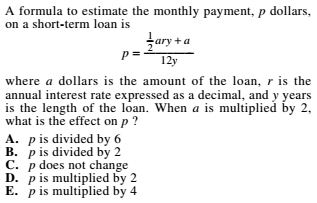
ACT Math questions can be confusing. Many leave readers wondering what's being asked and where to start. That's why it's such a good idea to have a reliable method for dissecting these questions in your back pocket. That way, whenever you sit down to a confusing ACT Math problem, you know where to turn.
In this artcile, I outline four fool-proof steps to clearing up what a question is asking, as well as offering a few other tips for attacking ACT Math.
4 Steps to Understanding ACT Math Questions
The point of these steps is to discover what the question is really getting at. Often, some of the multiple-choice answers you're offered are the right answers to the wrong questions, and you don't want to be duped into selecting one of these red herrings. Instead of panicking over how confusing it all is, stay calm and start with this method.
1. Read the Problem
Just read, and see where you stand as far as sizing up the situation.
Take a look at this question:

Now, it may look intimidating, but it's pretty clear what the actual question is: what is $c$?
From there, we can plug in what we know ($f = 450$ and $d = 10$), and we get:
$450 = c(10)^3 = 1000c$
Divide to isolate the variable, and $c = 0.45$
 Yes! We figured it out!
Yes! We figured it out!
Alright, that was actually fairly straightforward. How about this one?

There's more going on in this question. An initial read does, though, reveal a couple of things:
- This question will require further attention.
- We're talking about functions on a graph.
At least we know basically what we're dealing with as we proceed to the next step.
2. Find the Given Information
This includes question and command terms. Now, not all questions will be technical questions; some will contain command terms, like find, state, or identify.
Pick out whatever it is that tells you what's being looked for. In the above problem, I see the word which: "Which... describes a true relationship...?" Basically, this question is just asking which of the following statements is true!
Also identify any given information, including stated quantities such as dimensions or simple numbers. This includes units—it's not much good to know there are 15 unless you know 15 of what. Also look at any other labels that give you information about the quantities in question.
In the question above, I see $f(x) = (x - 3)^2 + 2$ and $g(x) = 1/2x + 1$. No units, but that's okay; we're working with functions on a graph in a purely abstract sense—not quantities in the real world.
If there's any extraneous information, you can eliminate it this point. For example, take a look at this problem:

Look at the question: "When $a$ is multiplied by 2, what is the effect on $p$?"
To answer the question, do we really need to know what the formula represents (a short-term loan)—or what any of the variables mean? Not really! So, we can eliminate everything but the formula itself and the last sentence.
From there, we can see that we could rewrite the formula as $p = a ({1/2ry+1}/{12y})$. Getting back to the original question, multiplying $a$ by 2 results in multiplying the whole right-hand side of the equation by 2, as follows: $2a({1/2ry+1}/{12y})$. What you do to the right side you must do the left, so $p$ is also multiplied by 2 at this point, making the answer D.
 It's sort of like finding clues—you're a math detective!
It's sort of like finding clues—you're a math detective!
3. Look to the Answer Choices
What differs from option to option? Whatever's changing is what the question must be testing.
If you're still not sure what the question is, look at the answer choices and ask yourself what question they could answer. Units are hugely helpful in this: "25 miles" will not answer how many more cookies Sam has than Lucy, but it might answer how far Sam's house is from Lucy's.
In the question about the two functions on the graph, we're looking for a true statement among answer choices, so of course we have to examine those answer choices to see what we're working with. Answer choice (F) is true, and none of the others are, so that settles that:
- The graphs touch at two points.
- The one is sometimes lower, sometimes higher than the other.
- The graphs are very different; they do not look like direct inverses of each other.
Sometimes, the answer won't fall into place just yet. In that case, continue on to the next step.
4. Rephrase the Question to Make Sense
For instance, we could say for the graphing question, "Which statement is true about this graph?"
You've dissected a lot about this problem; now, put it all back together. At this point, you can pretty much ignore the original, convoluted wording (keep it around for reference just in case)—stick to what you've boiled it down to.
Now, go forth and solve!
 You're on a quest to conquer the mathematical dragon of the ACT!
You're on a quest to conquer the mathematical dragon of the ACT!
Other Tips for Working with ACT Math Problems
Here are a few pointers to working with all ACT Math problems, including those that are hard to parse.
Recognize Information Stated Different Ways
There are a lot of ways to say the same thing: the ability to recognize the same info in different forms is key. For instance, be very handy with mathematical vocabulary and the symbolic/numeric representations that are often used. When you see $y = f(x)$ on a graph, it means essentially the same as, "The graph of $f(x)$ is shown on the xy-coordinate plane above." Mere wording can also contribute to difficulty in understanding a problem, so keep track of unnecessarily florid terminology as you go; note where a problem says "increases" instead of "grows", etc.
Take Things One Step at a Time
You don't need to see all the way to the end result when you're beginning a problem; just take the next available step and see where it leads. The great thing about deductive disciplines such as math is that they proceed relatively linearly; one piece of information allows you to advance to the next until you get to the end. If you're in a factored form, expand; if you're in the expanded form, factor. Do whatever's available to you, and see what you glean.
Work Backwards If You're Not Sure Where to Go Next
This is a multiple-choice test: plug answers in and try them out. Start with any answer you like and treat it as the answer. Stick it into the problem and see if it works out. If it does, great! If it doesn't, go ahead and try it with another answer choice. Your options for a correct answer are limited; take advantage of this fact and apply process of elimination.
Ferret Out the Information You've Been Given
There is always enough information to answer the question. Unless there's an answer choice that specifically says, "Not enough information is given," you can find a concrete answer to what's being asked. You may need to use information to find other information that you then use to solve—the path is not always perfectly direct, but there's always a path. If there's one piece of information that you really need to solve and the test doesn't give it to you, there must be a way of figuring it out.
 The information has to be here somewhere!
The information has to be here somewhere!
"If" Is Not an Option
If does not indicate a mere possibility. When the ACT says, "If Bob invests $500 in his bank account...", the ACT means, "Bob invests $500 in his bank account, end of story." For the purposes of a math problem if indicates something that's known to be true. Don't let that throw you off—when you see if, you can trust that information: no need to doubt it.
Notice the "Notes"
"Note" means you should pay attention. Some problems will give you a note about a formula or conversion factor that you'll need to use. Don't ignore it—it's a freebie. It's easy to skim over the note at the end, but that would be a mistake. It's definitely true that there's always enough information to answer the question, but you do have to search for it and not skip over what you're given.
Start Somewhere
Get your pencil moving. The main thing is to start a problem and get over that initial momentum hurdle. Once you're working, it's a lot easier to keep going than it was to get started. Try something. Make a note. Plug in a number. Just get started with something, follow the tips outlined above, and don't let a problem stop you in your tracks. At least toy with a question before you jump to guessing.
Conclusion
When you're working with a confusing math problem, stay calm and come back to the information you've been given. Read the problem, identify the given information, look to the answer choices, and rephrase the question.
Also, keep the big picture in mind: there's a whole section's worth of math problems to be solved. That means there are many more opportunities to shine; it's OK to skip a problem and come back to it later—or even guess. Unless you're confidently aiming for a perfect 36, no one question is going to make or break it all.
Do your best, but don't beat yourself up if your best isn't perfect; master what you can as you progress.
 Respect your own journey.
Respect your own journey.
What's Next?
Getting stuck happens. Accept that it's going to happen to you, and read about how you can work with that experience.
Practice with some really tough problems; that way, you'll be prepared for the worst of it on actual test day.
You might also want to spend some time thinking about word problems, as these are often some of the trickiest to work though in terms of figuring out what's being asked.
Want to improve your ACT score by 4 points?
Check out our best-in-class online ACT prep program. We guarantee your money back if you don't improve your ACT score by 4 points or more.
Our program is entirely online, and it customizes what you study to your strengths and weaknesses. If you liked this Math lesson, you'll love our program. Along with more detailed lessons, you'll get thousands of practice problems organized by individual skills so you learn most effectively. We'll also give you a step-by-step program to follow so you'll never be confused about what to study next.
Check out our 5-day free trial:
Have friends who also need help with test prep? Share this article!

Vero is a firsthand expert at standardized testing and the college application process. Though neither parent had graduated high school, and test prep was out of the question, she scored in the 99th percentile on both the SAT and ACT, taking each test only once. She attended Dartmouth, graduating as salutatorian of 2013. She later worked as a professional tutor. She has a great passion for the arts, especially theater.


































 Holly R.
Holly R.